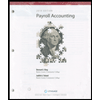
1.
Concept Introduction:
Deferred expense: The advance payments for future expenses, when a business prepays an expense it can debit an asset account and defer the recognition of the expense are a deferred expense. Deferring an expense creates an asset, thus the account is debited to recognize this prepayment.
The adjustment entry for accrued salaries on December 31.
2.
Concept Introduction:
Adjusting entries: The entries are recorded at the end of the accounting period and record revenues to the period in which they are earned and expenses to the period in which they occur.
The adjustment entry to record earning of revenue.
Want to see the full answer?
Check out a sample textbook solution
Chapter 3 Solutions
Pearson eText Horngren's Financial & Managerial Accounting: The Financial Chapters -- Instant Access (Pearson+)
- I need help solving this general accounting question with the proper methodology.arrow_forwardCan you solve this general accounting problem using appropriate accounting principles?arrow_forwardPlease provide the correct answer to this general accounting problem using valid calculations.arrow_forward
- Stockholders' equity at the end of the year was ____.arrow_forwardI need the correct answer to this general accounting problem using the standard accounting approach.arrow_forwardThe installation of a ______ system will create confidence in the minds of public about the fairness of the prices charged. a. Costing b. Financial accounting c. Management accounting d. Informationarrow_forward
 College Accounting, Chapters 1-27AccountingISBN:9781337794756Author:HEINTZ, James A.Publisher:Cengage Learning,
College Accounting, Chapters 1-27AccountingISBN:9781337794756Author:HEINTZ, James A.Publisher:Cengage Learning, Cornerstones of Financial AccountingAccountingISBN:9781337690881Author:Jay Rich, Jeff JonesPublisher:Cengage Learning
Cornerstones of Financial AccountingAccountingISBN:9781337690881Author:Jay Rich, Jeff JonesPublisher:Cengage Learning
 Intermediate Accounting: Reporting And AnalysisAccountingISBN:9781337788281Author:James M. Wahlen, Jefferson P. Jones, Donald PagachPublisher:Cengage Learning
Intermediate Accounting: Reporting And AnalysisAccountingISBN:9781337788281Author:James M. Wahlen, Jefferson P. Jones, Donald PagachPublisher:Cengage Learning Financial Accounting: The Impact on Decision Make...AccountingISBN:9781305654174Author:Gary A. Porter, Curtis L. NortonPublisher:Cengage Learning
Financial Accounting: The Impact on Decision Make...AccountingISBN:9781305654174Author:Gary A. Porter, Curtis L. NortonPublisher:Cengage Learning Financial AccountingAccountingISBN:9781337272124Author:Carl Warren, James M. Reeve, Jonathan DuchacPublisher:Cengage Learning
Financial AccountingAccountingISBN:9781337272124Author:Carl Warren, James M. Reeve, Jonathan DuchacPublisher:Cengage Learning





